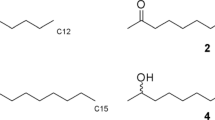Abstract
Whole body extracts of the termite,Reticulitermes speratus, were subjected to various chemical operations and bioassays to examine the presence of trail-pheromone precursor. Fractions that mainly contained fatty acid esters were obtained from hexane extracts by means of silica gel column chromatography. Trail-following activity of the fractions was activated by alkaline hydrolysis, while the original fractions did not show any conspicuous activity. Bioassay showed that the activity of hydrolyzed product was approximately 20 times as high as the original hexane extract. This suggests that the precursor candidate could be stored in termite bodies as an esterified form. Chemical analyses revealed that the complete structure of the hydrolyzed product was coincident with that of the native pheromone ((Z,Z,E)-3,6,8-dodecatrien-1-ol).
Similar content being viewed by others
References
Birch, A.J., Brown, W.V., Corrie, J.E.T., andMoore, B.P. 1972. Neocembrene-A, A termite trail pheromone.J. Chem. Soc. Perkin. Trans. I. 1:2653–2658.
Grace, J.K. 1987. Chemically mediated behavior of the western subterranian termite.Reticulitermes hesperus Banks (Isoptera: Rhinotermitidae).Diss. Abstr. Int. 48(5): (English).
Grace, J.K., Wood, D.L., andFrankie, G.W. 1988. Trail-following behavior ofReticulitermes hesperus Banks (Isoptera: Rhinotermitidae).J. Chem. Ecol. 14:653–667.
Hall, P., andTraniello, J.F.A. 1985. Behavioral bioassays of termite trail pheromones. Recruitment and orientation effects of cembrene-A, inNasutitermes costalis (Isoptera: Termitidae) and discussion of factors affecting termite response in experimental contexts.J. Chem. Ecol. 11:1503–1513.
Howard, R., Matsumura, F., andCoppel, H.C. 1976. Trail-following pheromones of the Rhinotermitidae. Approaches to their authentication and specificity.J. Chem. Ecol. 2:147–166.
Kaib, M., Bruinsma, O., andLeuthold, R.H. 1982. Trail following in termites. Evidence for a multicomponent system.J. Chem. Ecol. 8:1193–1205.
MacFarlane, J. 1983. Observation on trail pheromone, trail laying and longevity of natural trails in the termiteMacrotermes michaelseni.Insect Sci. Appl. 4:309–318.
Matsumura, F., Coppel, H.C., andTai, A. 1968. Isolation and identification of termite trail-following pheromone.Nature 219:963–964.
Matsumura, F., Coppel, H.C., andTai, A. 1969. Termite trail-following substance, isolation and purification fromReticulitermes virginicus and fungus-infected wood.J. Econ. Entomol. 62:599–603.
Matsumura, F., Jewett, D.M., andCoppel, H.C. 1972. Interspecific response to synthetic trail-following substances.J. Econ. Entomol. 65:600–602.
Moore, B.P. 1966. Isolation of the scent-trail pheromone of an Australian termite.Nature 211:746–747.
Moore, B.P. 1969. Biochemical studies in termites, pp. 407–432,in K. Krishna and P.M. Weesner (eds.). Biology of Termites, Vol. 1. Academic Press, New York.
Prestwich, G.D. 1984. Defense mechanisms of termites.Annu. Rev. Entomol. 29:201–232.
Prestwich, G.D., Eng, W.-S., Deaton, E., andWichern, D. 1984. Structure-activity relationships among aromatic analogs of trail-following pheromone of subterranean termites.J. Chem. Ecol. 10:1201–1217.
Ritter, F.J., andPersoons, C.J. 1975. Recent development in insect pheromone research, in particular in the Netherlands.Neth. J. Zool. 3:261–275.
Ritter, F.J., Bruggeman, I.E.M., Persoons, C.J., Talman, E., Van Oosten, A.M., andVerwiel, P.E.J. 1977. Evaluation of social insect pheromones in pest control, with special reference to subterranean termites and Pharaoh's ants, pp. 210–216,in N.R. McFarlane (ed.). Crop Protection Agents: Their Biological Evaluation. Academic Press, New York.
Stuart, A.M. 1961. Mechanisms of trail-laying in two species of termites.Nature 189:419.
Stuart, A.M. 1963. Origin of the trail in the termitesNasutitermes corniger (Motschulsky) andZootermopsis nevadensis (Hagen), Isoptera.Physiol. Zool. 36:69–84.
Stuart, A.M. 1969. Social behavior and communciation, pp. 193–232,in K. Krishna and F.M. Weesner (eds.). Biology of Termites, Vol. 1. Academic Press, New York.
Tai, A., Matsumura, F., andCoppel, H.C. 1969. Chemical identification of the trail-following pheromone for a southern subterranean termite.J. Org. Chem. 34:2180–2182.
Tai, A., Matsumura, F., andCoppel, H.C. 1971. Synthetic analogues of the termite trail-following pheromone, structure and biological activity.J. Insect Physiol. 17:181–188.
Tokoro, M., Takahashi, M., Tsunoda, K., andYamaoka, R. 1989. Isolation and primary structure of trail pheromone of the termite,Coptotermes formosanus Shiraki (Isoptera: Rhinotermitidae).Wood Res. 76:29–38.
Yamaoka, R., Tokoro, M., andHayashiya, K. 1987. Determination of geometric configuration in minute amounts of highly unsaturated termite trail pheromone by capillary gas chromatography in combination with mass spectrometry and fourier transform infrared spectroscopy.J. Chromatogr. 399:259–267.
Author information
Authors and Affiliations
Rights and permissions
About this article
Cite this article
Tokoro, M., Yamaoka, R., Hayashiya, K. et al. Evidence for trail-pheromone precursor in termiteReticulitermes speratus (Kolbe) (Rhinotermitidae: Isoptera). J Chem Ecol 16, 2549–2557 (1990). https://doi.org/10.1007/BF01017477
Received:
Accepted:
Issue Date:
DOI: https://doi.org/10.1007/BF01017477




